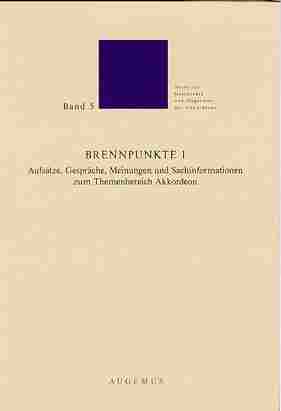The Free-Reed Review
Critiques of Compact Discs, Books and Music Scores
Book Review: Brennpunkte I (Band 5)
Aufsätze, Gespräche, Meinungen und sachinformationen zum Themenbereich Akkordeon

total pages: 107
6 music examples
11 illustrations
4 tables
Published: 1995
review date: April 1999
Publisher:
AUGEMUS - Musikverlag Ralf Kaupenjohann
Bleckstr.
1a
D-44809 Bochum
Germany
|
Contents:
- Editorial
Komponisternporträt
- Der Komponist David P. Graham im Gespräch mit Helmut C. Jacobs
Chistoph Keller
David P. Graham: Four Short Pieces—Werkbetrachtung
Werkberzeichnis von David P. Graham
- Artikel
- Ralf Kaupenjohann
Qualitätskriterien für italienische Stimmplatten
- Berichte
- Maria Dunkel
Rückblich auf die Akkordeonausstellung des Brüsseler Instrumentenmuseums vom Sommer 1994
Ralf Kaupenjohann
Das Akkordeon in der Konzertmusik. Atelierkonzerte des WDR 1993 in Köln
Anhang I: Vom Accordion zum Akkordeon . Die Emanzipation eines Konzertinstruments
Anhang II: Programme der Atelierkonzerte "Das Akkordeon in der Konzertmusik"
- Ute Pukropski
- Kompositionen für Akkordeon von Christoph Keller --Ein Seminar mit dem Komponisten auf dem Jugendhof Vlotho
- Martin Vogt
- Das Harmonium und seine Musik. Bericht zum Wochenendseminar vom 19. - 20. Februar 1994 in Vlotho
Ralf Kaupenjohann:
Anhang I: Harmonium-Literaturliste
Anhang II: Harmonium-Bibliographie
Anhang III: Tonträger mit Harmoniummusik
- Besprechungen
- Bärbel Hölzing
Lisa Ann Cleveland: An Analysis of Referential Collections in the Contemporary Accordion Works of Torbjörn Iwan Lundquist
Helmut C. Jacobs
Carlos Kuri: Piazzolla. La musica limite
Stefan Kames
Aus der Geschichte des Hm-ta-ta
Wolfgang Eschenbacher: Musik und Musik-erziehung mit Akkordeon
Jutta Lambrecht
Bärbel Hölzing: Torbjörn Iwan Lundquist: Werkverzeichnis und Diskographie
Norbert Laufer
Zwei Bücher zu Jürg Baurs 75.
Geburtstag: Werkverzeichnisse, Analysen und persönliche Worte
Jutta Scholl (Hrsg.): Der Komponist Jürg Baur. Eine Dokumentation
Lutz-Werner Hesse/ Armin Klaes/ Arnd Richter (Hrsg.): Jürg Baur. Aspekte seines Schaffens
Martin Vogt
Christoph Wagner: Das Akkordeon - Eine wilde Karriere
- Stellungnahmen
- Jürg Baur
Stellungmahme zu der Ausgabe meiner Drei Stücke im alten Stil für Oboe als Ubertragung für Akkordeon
Thomas Blomenkamp
Stellungnahme zu der Ausgabe meiner Drei Arabesken für Oboe als Ubertragung für Akkordeon
|
Review by Henry Doktorski:
Scholarly books about the accordion are as rare as accordion scholars, but
Ralf Kaupenjohann has admirably succeeded in putting the two together in a
fascinating anthology of essays, conversations, reviews and factual
information about the accordion, titled Brentpunkte I —Hot
Points.
The first section of Brennpunkte I is an introduction called
Editorial.
The second section, titled Komponisternporträt (A Portrait of the
Composer)—featured composer David P. Graham. There were three parts:
the first: an interview with Graham by concert accordionist Helmut C.
Jacobs. Two pages from the score of Graham's Shards (a concerto
for accordion and nine instruments (flute/ piccolo, oboe, clarinet,
bassoon, horn, percussion, viola, cello and contrabass) were reproduced.
The second part was a short article by Christoph Keller which described
Graham's Four Short Pieces for violin and accordion. Included
were musical examples from each movement. The third part was a list of
Graham's complete works.
The third section, Artikel (by Ralf Kaupenjohann) was an
explanation of the manufacture of Italian reeds, along with several
illustrations.
The fourth section, titled Berichte (Reports), was composed of
nine sections by four authors. Maria Dunkel wrote about A Backward
Glance of the Accordion Exhibit of the Brussels Instrument Museum in
Summer of 1994 . Ralf Kaupenjohann wrote three articles: 1) The
Accordion in the Concert Music of the Studio Concerts of WDR 1993 in Köln,
2) The Emancipation of the Concert Instruments (a brief
history of the accordion), and 3) The Accordion in Concert Music.
Ute Pukropski wrote about the compositions for accordion by Christoph
Keller and Martin Vogt wrote a wonderful introduction to the harmonium,
which explained the difference between a Saugluftharmonium and a
Druckluftharmonium (a harmonium which has a bellows which sucks
air in and a harmonium which as a bellows which blows air out) and also
included a chart of stops. This part concluded with three sections by Ralf
Kaupenjohann: the first was a list of original works for harmonium, the
second a bibliography, and the third: a discography of recordings of works
written for harmonium.
The fifth part, Besprechungen, or Critical Reviews, was composed
of eight sections. Bärbel Hölzing wrote about American Lisa Ann
Cleveland's dissertation: An Analysis of Referential Collections in
the Contemporary Accordion Works of Torbjörn Iwan Lundquist. Helmut
C. Jacobs wrote about Carlos Kuri's article about Piazzolla— La
musica limite, and Stefan Kames wrote an incredibly comprehensive
article about Wolfgang Eschenbacher's Music and Music Education with
Accordion. Jutta Lambrecht wrote about Bärbel Hölzing's Torbjörn
Iwan Lundquist: Catalog of Works and Discography. Norbert Laufer
wrote about Two Books of Jürg Baur's 75th Birthday: Catalog of Works,
Analysis and Personal Comments. Finally, Martin Vogt wrote about
Christoph Wagner's book: Das Akkordeon - Eine wilde Karriere—(A
Wild Career).
Truly, this publication will be treasured by German-readers as well as
non-German-readers. Although my knowledge of German is limited, as I
explained earlier, I still found this volume, Brennpunkte I, to
be invaluable in my own research for my book The Classical Squeezebox,
as I found the chapter on the original repertoire for harmonium to be
unexcelled. I believe all scholars and lovers of the accordion (and
harmonium) should have this book in their library.
